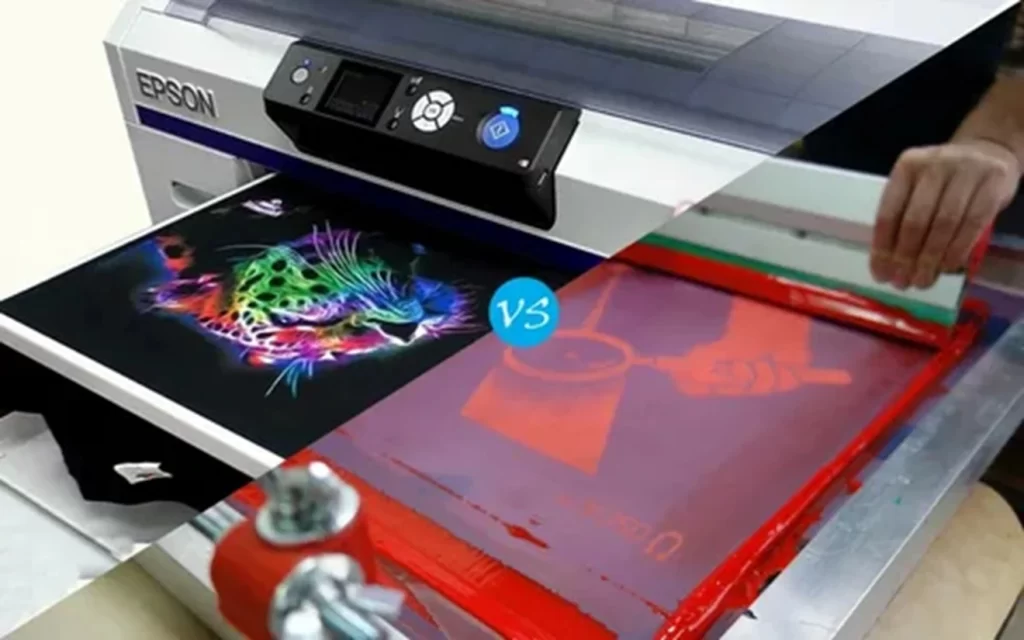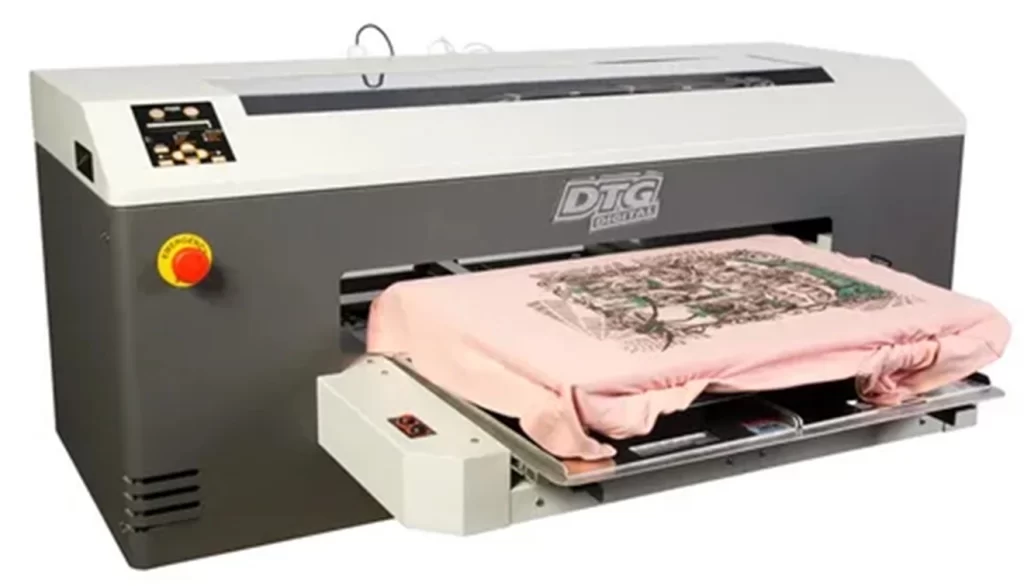DTG Printing vs Heat Transfer [Comparison Guide 2025]
Are you looking to start a T-shirt printing line? Can’t decide which printing technique is best for you? This post will give you an overview of the most common printing techniques and how they work.
Choosing the printing technique can make or break your printing business. The right one will not only fasten the production volume but also make you happy when things go in flow.
To gloom and boom in the garment printing industry, two printing methods have risen to the top! These are DTG printing vs Heat transfer; each one with its specific pros and cons.
But when it comes to choosing the right method for your project, going through the differences can be tricky. These techniques led to a new revolution in the design of apparel printing. Each approach comes with a package of advantages and limitations.
Being aware of the ins and outs of both methods is vital to be able to decide whether one method is better than the other. That’s why this guide is compiled for clear knowledge about DTG printing vs heat transfer.
So, tighten your seatbelts to go on a bumpy ride of exploring both printing techniques.
Table of Contents
Direct-to-garment (DTG) Printing
Direct-to-garment printing uses specialized inkjet technology to print any design directly onto garments. This method is preferred widely for its capability to produce even complicated designs with a high level of detail and color accuracy.
Unlike common printing methods, DTG doesn’t involve screens nor much time spent on setups which makes it a very efficient and cheap alternative for small batches and complex designs. This printing technology has come a long way in a short time.

How does DTG work?
Step 1: The process starts with the design preparation to be printed digitally. The design is usually prepared in the software and then carefully printed after that.
Step 2: For some fabrics (mainly dark-colored) T-Shirts are pretreated for the DTG treatment before the printing is carried out to ensure the ink adheres properly to the textile surface. In this process, the pigment is set in the fabric for the perfect hue and longevity of the print.
Step 3: Then, the fabric is gently loaded onto the printer’s platen or bed to ensure that is flat and correctly positioned for printing. Some garment printers allow four garments at a time.
Step 4: The DTG printer applies ink directly onto the fabric, following the digital design file. It precisely deposits the ink onto the garment’s surface to produce detailed and accurate colorful designs.
Step 5: When the printing is over, the garment will proceed to a curing stage (heat press for 2 minutes, ) or drying period (depending on the kind of ink used). This process not only dyes the fabric but also sets the ink into the cloth to provide it durability and washability.
Step 6: After the curing stage, the printed garment undergoes quality control checks to ensure the design has been accurately transferred and the colors appear vibrant and true to the original design. Once approved, the garment is ready for delivery to the customer.
Pros of DTG Printing
- Ideal for complex and detailed designs
- The final product is full-colored digital printing
- The print touch is very smooth and soft
- Suitable for small batches and custom prints
- Offers a wide range of color options with soft finish
- Excellent durability and color vibrancy
- Print cost is low per printed unit
Cons of DTG Printing
- Might not be as cost-effective for larger orders
- Limited compatibility with non-textile materials
- Printing speed is slow compared to screen printing

Heat Transfer
Heat transfer, on the other side, is a process that involves putting design on several surfaces with the help of heat. It usually uses heat press machines to apply the adhesive vinyl on the substrate to produce prints that are both reliable and long-lasting. This method is widely popular for its versatility in printing on fabrics, ceramics, and even wood.
This method typically involves two methods for heat transfers. The first one involves a heat press machine to transfer your custom vinyl cut-out onto the substrate. The second method uses special inks to print designs onto film or transfer paper and then heat pressed onto the shirt.
How does Heat Transfer Work?
Step 1: The process begins with the selection of a design that has to be transferred to the surface of the object. The digital file is printed out on heat transfer vinyl with a special printer machine.
Step 2: The pattern will be printed out onto a material, which will be cut by a cutting machine that will follow the contours of the design. This step makes sure the transferred design accurately replicates the original image.
Step 3: After cutting, the excess vinyl surrounding the design is removed in a process called weeding. It leaves only the desired design on the carrier sheet, ready for application.
Step 4: The cut and weeded design is carefully positioned on the substrate, such as a garment or any other material. It is essential to ensure that the design is correctly aligned and placed before proceeding further.
Step 5: With the help of a heat press machine, heat and pressure are applied to the carrier sheet with the design and the substrate. This heat causes the adhesive on the vinyl to bond with the surface of the substrate, effectively transferring the design onto the material.
Step 6: After the application of heat and pressure, the substrate is set to cool down. It is done so vinyl can adhere firmly to the surface. Once cooled, the carrier sheet is peeled off, leaving the transferred design on the substrate.
Step 7: To increase the trust of the customers’ side for your business, a quality check of the final product is done. The transferred design undergoes it to check the print has accurately adhered to the substrate. It assures the colors and details are consistent with the original design.
Pros of Heat Transfer
- Cost-effective for larger orders
- Durable and long-lasting prints
- Design with complex and multiple colors is easy to execute simultaneously
- High versatility across various materials/fabrics (polyester, nylon, cotton, etc)
- Can withstand multiple washes up to 50-60 washes
- Complicated designs can easily transferred onto the fabric
- Can customize multiple garments in the same go
Cons of Heat Transfer
- Longer production time for intricate designs
- Prints are not as durable as with DTG printing
- Colors may fade over time
Comparison Between DTG Printing VS Heat Transfer
Both DTG printing and heat transfer have unique benefits. However, understanding their differences is important in making the right choice for your printing needs. Here’s a detailed comparison of DTG printing vs heat transfer:
| Features | DTG Printing | Heat Transfer |
| Print Quality | High-quality, detailed prints with vibrant colors | Good quality prints, but may not be as detailed or vibrant as DTG prints |
| Durability | Prints are very durable and resistant to fading | Prints are relatively durable but may fade over time |
| Versatility | Best for cotton fabrics | Can be used on a wide variety of fabrics |
| Cost | More expensive per garment | Less expensive per garment |
| Minimum Order Quantity | No minimum order quantity | Usually requires a minimum order quantity |
| Turnaround Time | Faster turnaround time | Slower turnaround time |
DTG Printing vs Heat Transfer: Which One Should You Choose?
In the printing line, the method you choose for garment printing can make or break you. When deciding between DTG printing vs heat transfer, first consider your specific requirements, budget constraints, and the complexity of your designs.
For small batches, intricate artwork, and vibrant color requirements, DTG printing might be the ideal choice. On the other hand, if you’re working with diverse materials and larger orders, heat transfer could offer the versatility and cost-effectiveness you need.
